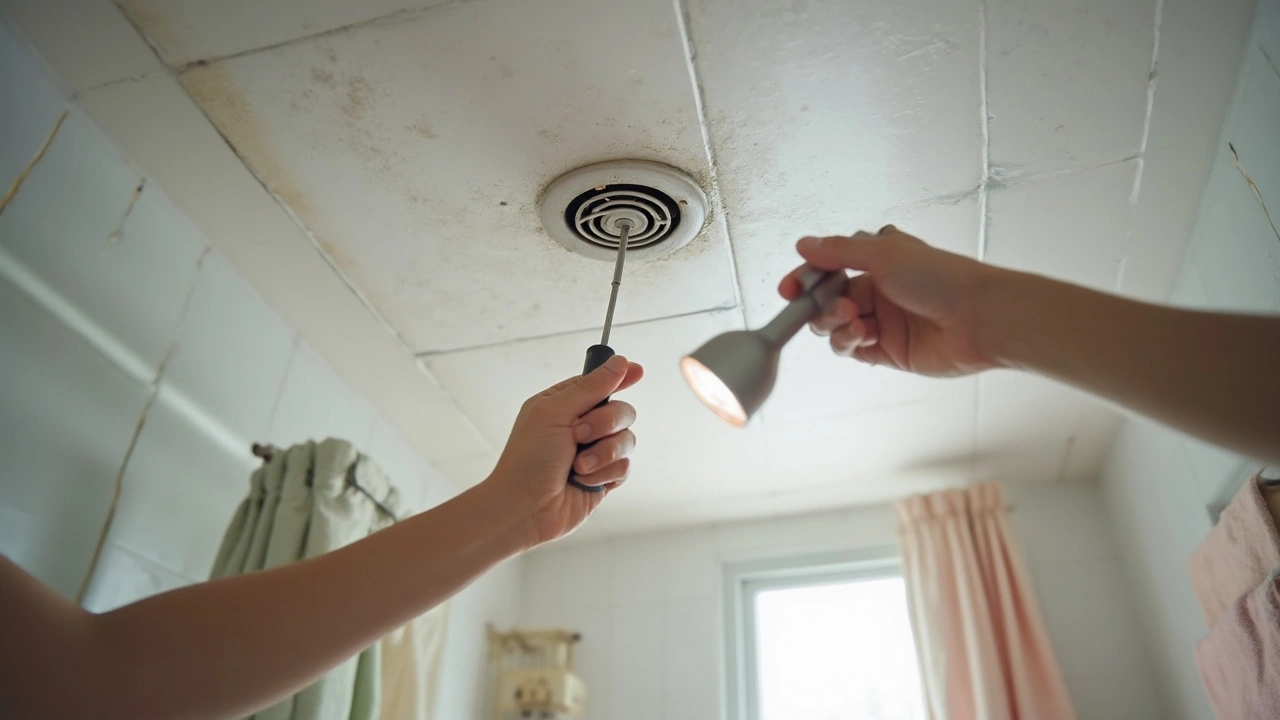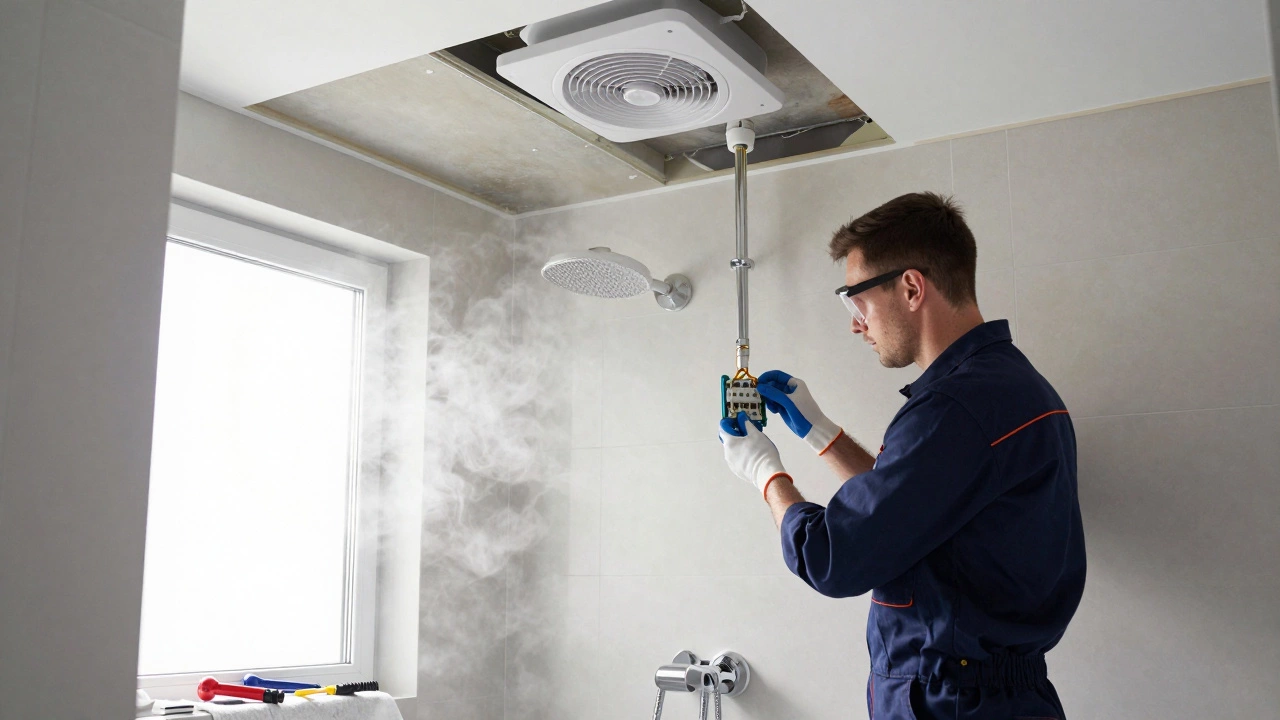
- 18 Jun 2025
- Gideon Thornton
- 0
Extractor fans can be lifesavers in stuffy kitchens and damp bathrooms, but when they stop working, things go downhill fast. If yours has started making weird noises or given up spinning altogether, you’re probably wondering: should you call an electrician, or is this a job for someone else?
Here’s the thing—most extractor fans are wired straight into your home’s electrical system. That means fixing them safely is usually a task for a qualified electrician, not just a general handyman. Don’t be tempted to poke around if you’re not trained; a bad wiring job or loose connection could lead to tripped breakers or even a fire hazard.
There are some cases, of course, where the problem is as simple as a clogged filter or stuck cover you can clean yourself. But once things get past dust and grime—like with strange burning smells, constant fuse trips, or that “nothing happens when I flick the switch” moment—a professional is your safest bet. Electricians can quickly spot if the issue is wiring, switches, or the fan itself, saving you time and random guesswork.
- What Does an Electrician Actually Do?
- Extractor Fan Problems: The Usual Suspects
- How Electricians Repair Extractor Fans
- When a Repair Becomes a Replacement
- Tips for Keeping Your Fan Trouble-Free
What Does an Electrician Actually Do?
When you call in an electrician for any job around the house, their main goal is to make sure everything electrical runs safely, and that includes your extractor fan repair needs. These pros are trained and certified to work with wiring, connections, switches, and anything else tied into your electrical system.
Electricians’ work covers a wide range of tasks, but with extractor fans, they usually deal with:
- Troubleshooting dead fans (they test to see if power is reaching the unit at all).
- Fixing or replacing broken wiring and loose terminals.
- Checking and changing out faulty switches or isolators.
- Testing circuit breakers and fuses that might be cutting off electricity to the fan.
- Replacing burnt-out motors or worn fan units.
If you’re dealing with all the right wires in all the wrong places, electricians know how to trace the mess using special test meters and tools. They follow strict safety codes—like the UK’s Part P regulations—to make sure everything they do is legit and keeps you protected.
Here’s a handy comparison of what jobs electricians handle with extractor fans, versus jobs best left for other pros:
| Task | Electrician | DIY or Other Pro |
|---|---|---|
| Fixing wiring, fuses | Yes | No |
| Installing new fan | Yes | Maybe (if just like-for-like and you know your stuff) |
| Cleaning dust and filters | No | Yes |
| Replacing a broken cover | No | Yes |
| Rewiring for upgraded fan | Yes | No |
Some electricians specialize even more—like in kitchens or bathrooms—where ventilation fan rules are tight due to steam or safety concerns. So if you want to stay safe (and avoid the chaos of blown fuses or tripped circuits), get the right expert for the job.
Extractor Fan Problems: The Usual Suspects
Extractor fans aren’t complicated machines, but when they act up, the symptoms can leave you scratching your head. Here’s a look at the most common problems, how to spot them, and what usually causes that kitchen or bathroom fan to quit.
The first thing to watch for is noise—grinding, rattling, or squealing. Most of the time, this means dust or grease build-up, worn-out bearings, or the fan blade catching on something. Fans running noisily can also point to a loose mounting or parts that vibrate against the wall.
Another classic: the fan won’t turn on at all. Sometimes, it’s as simple as a blown fuse or a tripped circuit breaker, especially if you notice another appliance on the same circuit is also dead. More commonly, you’ll find a faulty switch, broken wiring, or a burned-out motor.
Weak or nonexistent airflow is high on the list, too. If you’re leaving the bathroom foggy after every shower, check for blockages. Fans clogged with dust, lint, or (in the kitchen) sticky grease can barely move air. Don’t forget about the outdoor vent cover getting stuck or jammed by debris either.
Then there’s the smell test. Burning or musty odors point to electrical shorts, a fried motor, or trapped moisture growing mold inside the ductwork. If you smell something burning, flip the switch off and don’t mess around—call an electrician fast.
Here’s some quick hard data on what usually sends extractor fans to the repair pile:
| Problem | Main Causes | Percentage Seen by Electricians |
|---|---|---|
| Noisy operation | Dust build-up, loose parts, worn bearings | 34% |
| Not turning on | Wiring fault, dead motor, broken switch | 28% |
| Weak airflow | Clogged ducts, dirty blades, stuck vent | 22% |
| Bad smells | Burned-out motor, mold, electrical short | 16% |
Here’s a quick checklist to help figure out if your fan trouble is a simple fix or calls for a electrician:
- Loud rattling or grinding—try cleaning, but don’t ignore persistent noise
- No power at all—check fuses, then call a pro if you don’t spot anything obvious
- Fan spins but doesn’t pull air—inspect for clogs or stuck vent covers
- Burning smell—switch off right away and don’t use until checked
Knowing the likely problems can save you some frustration—and maybe a little cash—before you get someone out for extractor fan repair.

How Electricians Repair Extractor Fans
So what actually goes on when an electrician shows up to deal with your broken extractor fan? They don’t just poke around randomly—they follow a systematic process to find out why your fan’s quit or why it’s acting strange.
Electricians start by cutting power at the breaker. This isn’t just about safety—fans are usually connected to dedicated circuits, so flipping the right switch avoids bigger electrical problems. Next, they run through a set of diagnostic checks. Here’s a rough breakdown of how pros tackle extractor fan repair jobs:
- Visual Inspection: They look for obvious stuff: burnt wires, damaged housing, loose screws, or gunked-up filters and blades.
- Wiring Checks: Using a multimeter, they check if electricity reaches the fan. Sometimes the wiring behind your wall is the issue—not the fan itself.
- Testing the Switch: Faulty or sticky wall switches are classic culprits. Swapping out a dead switch can sometimes fix the whole thing.
- Fan Motor Assessment: If the electricity gets there but the motor stays silent (or screams like a banshee), it’s time to check if the motor’s burned out or clogged with dust.
- Removing Blockages: Built-up lint or debris can block airflow. An electrician will clean or swap out filters as needed.
Some repairs are fast—changing a fuse or reconnecting a loose wire. Other issues, like a fried motor, might mean replacing the whole fan. Experienced electricians spot the signs quickly, which means you’re not paying for endless trial-and-error.
And if you’re wondering how often common fan problems turn up, here’s a quick breakdown I rounded up from recent service reports:
| Issue | Percentage of Cases |
|---|---|
| Wiring Faults | 40% |
| Motor Problems | 25% |
| Blocked/Dirty Fans | 20% |
| Switch Faults | 10% |
| Other (timer, humidity sensor, etc.) | 5% |
Most of the time, a pro can fix your fan in about an hour—unless they need to order special parts. The good news? If it’s just wiring or a switch, you’ll probably have fresh air again before you know it.
When a Repair Becomes a Replacement
Sometimes, no matter how good your electrician is, there’s only so much they can do. If your extractor fan is over ten years old, it might just be tired out. Most fans have a shelf life of about 7–10 years, especially if they run often, as in busy kitchens or small bathrooms. If the motor’s burned out or the blades are cracked, repairing it isn’t always possible or cost-effective.
There are a few clear signs you need a new extractor fan instead of another round of repairs:
- The fan won’t turn on at all, even after trying the usual fixes like replacing fuses or checking the switch.
- You hear loud grinding or screeching sounds, which usually point to worn-out bearings or a failing motor.
- The fan is humming but not moving any air, showing the blades or motor are shot.
- Visible damage—like melted plastic, burn marks, or corroded parts—pops up when your electrician checks the inside.
- Repeated electrical issues, like tripped breakers every time you use the fan, which could mean there’s a bigger wiring problem inside the unit.
Upgrading to a new extractor fan doesn’t just fix the immediate problem. Many newer models use a lot less power and run quieter than the old ones from a decade ago. Plus, modern fans often have smart features—think humidity sensors that switch on automatically or eco modes that save on your energy bills.
A good electrician can handle both the removal of the old unit and the wiring of the new one, making sure everything meets today’s standards and local codes. If you’re putting in a more powerful fan, you might even need a slightly bigger fuse or new wiring—that’s another job for the pros. Don’t forget to keep the receipt and manual from your new fan, just in case you need service or want to claim a warranty down the road.

Tips for Keeping Your Fan Trouble-Free
Keeping your extractor fan in top shape doesn’t have to be complicated. A little regular care stops most problems before they start—and keeps damp, smells, and grease from taking over your home. Here are some simple habits that actually make a difference:
- Extractor fan repair isn’t always needed if you clean the grill and fan blades. Dust and grime can sneak in fast, especially in kitchens. Use a vacuum brush or a damp cloth (with the power off!) every few months.
- Check filters if your fan has them. Most kitchen fans use grease filters that clog up over time. Clean them with hot, soapy water or replace them as the label says—usually every three to six months.
- Listen for odd sounds. Squeaking, rattling, or grinding often mean something’s come loose or needs oil. Jump on these sounds early so you don’t end up needing full repairs.
- Try the “tissue test.” Hold a tissue up to the grill while the fan’s running. It should stick. If not, you might have a blockage or a dodgy motor.
- Wipe off condensation. In bathrooms, mop up steam and splashes near the fan, which helps prevent mold attacking the inside parts.
Want to know what usually goes wrong and how often fans need help? Here’s a quick look at issues and their frequency in UK households:
| Common Issue | Percent of Cases | How to Prevent |
|---|---|---|
| Dust/grease buildup | 43% | Wipe fan and clean filters every 3-6 months |
| Wiring faults | 22% | Don’t fiddle with wiring; call an electrician |
| Blocked vents | 19% | Clean external covers yearly |
| Motor wear | 12% | Listen for noise; replace as needed |
| Timer failure | 4% | Check settings, replace timer if unreliable |
If you ever notice burning smells, the fan just won’t switch on, or the cover gets hot, power it off and let an electrician check things out. Most fans last around 7–10 years if you keep up with cleaning and listen for signs of trouble. That’s less work than you’d think—and a lot less hassle than dealing with constant damp or having to replace the whole unit early.




